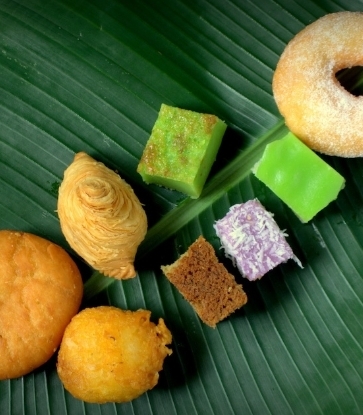Despite being a native of Japan, the idea of visiting the country's southern Okinawa island has never crossed Tomoyuki Kiga's mind.
The chef de cuisine of Akira Back Singapore had always thought of the prefecture as a resort island, a place to go for a relaxing getaway. But an unexpected encounter with a batch of fish from Okinawa changed this impression.
“One day, an Okinawa produce supplier in Singapore sent me a box of fish with some aji, mackerel, amberjack and bonito from Okinawa. My first thought was that the seafood won’t be as good as what we ordered from Tokyo, but I was wrong,” Kiga recounted.
“I can still recall how the bonito impressed me: it was lean, but had a nice firm texture, and it was flavoursome. From that moment on, I wanted to visit Okinawa and see the produce for myself.”
To feed his curiosity, Kiga accepted an invitation from his Okinawa supplier to visit several farms and a fish port in Okinawa, and later created a menu to showcase the island’s produce at Akira Back Singapore, a MICHELIN Plate restaurant. These are the highlights of Kiga's whirlwind four-day tour.

Discovering subtropical fruits
The southernmost prefecture of Japan, Okinawa has a subtropical climate, with the average temperature of 28 degrees Celsius in July and 15 degrees Celsius in January. Compared to other parts of Japan, Okinawa stays warm and humid throughout the year. Fruit and vegetables that do not grow as well elsewhere in Japan flourish here and have become the island's speciality produce.

One such fruit is acerola. Native to the islands of the Caribbean and Antilles, the cherry-like fruit travelled via Hawaii to Okinawa in 1958 as part of efforts to revive Okinawa after the war. Among the locals, acerola is enjoyed as a fruit or in the form of smoothies, ice creams and jams.
At Acerola Fresh, the largest farm on the island, farm owner Tetsuko Namisato explained to Kiga that acerola trees can grow as tall as 3.5m, but they are restricted to a height of 1m to protect them from the typhoons that regularly affect the region.
Pictured left: Tetsuko Namisato, the owner of Acerola Fresh, explains to chef Tomoyuki Kiga why they have to keep the tree to a height of one metre.
The bark of trees with few fruits are also trimmed frequently, so the trees will be stimulated to grow more flowers and eventually fruit.
The techniques, she said, are hard-earned wisdom from her late husband, Yasufumi Namisato. “Acerola did not adapt to our land well at the very beginning,” she explained.
The fruit trees only started to flourish in Okinawa in 1982, after her husband, who had a university degree in tropical agriculture, demystified the causes behind the low yield of acerola.

Today, Acerola Fresh alone produces 10 tonnes of acerola per year. Okinawa is the only place in Japan where acerola can grow in an open field, and the locals consider it a superfood due to its high levels of vitamins and polyphenols, Namisato said. The latter is said to be able to lower blood pressure, prevent diabetes complications, and alleviate fatigue. "If you look at the acerola flower closely, the top petal is always in a heart shape and the whole flower will eventually turn into the fruit. We like to think that every acerola is a carrier of love.”
Pictured right: Acerola Frozen, a sweet sorbet made with acerola, is a popular refreshment among the locals.

Tasting local citrus
Kiga was equally inspired by a visit to a citrus farm later the same day, where he encountered trees ripe with tankan, kabuchi and shikuwasa, three types of local citrus.
The shikuwasa, the farm's main crop, is a green citrus fruit native to Taiwan and Okinawa that has a unique citrusy taste not found in any other fruits. It is rich in vitamin C, antioxidants and citric acid. It also contains nobiletin, a polyphenol found in citrus fruits. The fruit is often referred to as the key to longevity by Okinawa locals, who believe that regular consumption of the fruit offers a multitude of health benefits such as fighting fatigue as well as lowering blood pressure and glucose levels.


According to the shikuwasa farm's owner, Kobashigawa Hiroshi, the fruit is harvested at different times in the year depending on how it is to be enjoyed.
For instance, the citrus is very sour in July and is harvested for pickling, while those harvested in October can be used to make juice. The fruit ripens and its skin turns orange in November, when it can be eaten as a fruit.
Kiga also visited farmers who grew purple yam, green pepper and Jew’s Mallow, a type of fibrous herb, to observe the extra care they employed in their agricultural processes.
Pictured left: Kobashigawa Hiroshi, owner of the shikuwasa farm, passes chef Tomoyuki Kiga a bag full of shikuwasa to enjoy.

A visit to a fish port was a highlight for Kiga, given that it was the local fish variety that first piqued Kiga’s interest in Okinawa. Okinawa is surrounded by the East China Sea and the Pacific Ocean, and the common types of fish caught in those waters are the big-eye scad, Indian mackerel, bonito and tuna.
But Kiga was not just fascinated by the types of fish available. “I want to see how they keep the fish fresh after they are caught,” he said.
At Kunigami Fisheries Cooperative, located at the northern part of Okinawa, Kiga found his answer: it was the choice of ice which made all the difference.
Local fishermen use a form of ice they call "sorbet ice", which has the soft texture of sorbet and no sharp corners.
Unlike the more commonly used ice cubes, crushed ice or cooling pads, sorbet ice does not scar the surface of the fish and can cover the fish completely without any gaps. This ensures that the fish is kept cool more effectively, according to Yoshihisa Murata, the cooperative's chief fisherman.

Kiga went on board a fishing boat to observe the whole process. Once the fish was caught and brought to deck, the fishermen would deftly break its neck or, in the case of larger fish, stab it in the brain according to the Japanese ike jime method, so that it died as soon as it left the water. It was then left to bleed out, and placed in a box of sorbet ice immediately after. This quick-kill method is crucial to ensuring the quality of the fish: it prevents the build up of lactic acid in the fish, which would give it an unpleasant taste and colour.
As much thought goes into the way the fish is packaged for overseas shipment after the fishing boat has returned to dock. In a packaging facility next to the port, the fishermen would first lay a plastic sheet at the bottom of a styrofoam box, followed by a layer of water-absorbent paper, the sorbet ice and then the fish.
According to a fisherman, each water-absorbent paper can absorb as much as two litres of water and the amount of ice used is decided based on the size of the fish. The optimal amount of ice is about 40 per cent of the volume of fish, which would allow the fish to arrive at its destination cold enough, but not soaked in water.

For the last step prior to dispatch, the fishermen attach a data log inside and outside the boxes, so their journeys can be closely tracked. Murata and his team are also working to reduce the amount of ice they need to pack into each box without compromising on the fishes' quality.
“Each delivery is charged by weight, so if we can reduce the amount of ice, we can reduce the price for our customer," he explains. Chef Kiga shared that he appreciated the careful steps the fishermen were taking.

An Okinawa-inspired feast
Once back in his kitchen in Singapore, Kiga translated his new-found knowledge of the Okinawa prefecture into a four-course menu for Akira Back Singapore at the JW Marriott Singapore South Beach, which is known for its modern Japanese cuisine featuring Korean accents and American influences.
A shipment of bonito, tsumuburi and Indian mackerel he received right after the trip arrived exactly as he saw at the port, Kiga said. "They were very fresh and everything was kept to the right temperature. The quality was really good."
In the first course, Katsuo, Kiga pairs a lightly seared bonito marinated in Japanese Tosa soy sauce with compressed watermelon, kaffir lime and herb puree.
The choice to use ingredients that are not traditionally Japanese is deliberate, said Kiga, and inspired by the local Okinawa dishes he sampled, such as taco rice, soki soba (braised pork feet with soba), goat soup, sea grapes and salted vanilla ice-cream.
“When I looked back on the food I had in Okinawa, it wasn’t like the Japanese food that I ate growing up. I wanted to pair the bonito with something that you usually wouldn’t expect to see, but still complemented each other,” shared Kiga.

The menu's second course, Buri, comprises Japanese amberjack fish smoked with cherry wood and marinated, ceviche-style, with shikuwasa vinaigrette. The dish is crisp and refreshing, and will cleanse the palate of the bold flavours from the Katsuo course, Kiga explained.
The main course, Rafute, is Kiga’s take on a common stewed pork belly dish in Okinawa. “Most people in Singapore can relate to a braised pork belly dish,” he explained.
Kiga retains the traditional use of Awamori sake and brown sugar in the recipe for the braising liquid, but uses less-fatty pork ribs in place of pork belly. The ribs are enveloped with the braising liquid and slow-cooked in a water bath for 48 hours to give the meat a tender texture without losing its structure.
For dessert, Kiga created a mille feuille filled with salted vanilla cream paired with acerola sorbet. “I was surprised at how well the savouriness and sweetness went together when I had the local salted vanilla ice cream,” Kiga said, “This dessert is my expression of that perfect combination of savoury and sweet.”
Kiga hopes to convey his thoughts on Okinawa to his diners via the menu.
“I used to think of Okinawa as a resort island and did not realise that it has an abundance of good quality ingredients,” said Kiga.
"I want the diners to see there are products that are special to Okinawa and that, in terms of quality, they do not lose out to products from Hokkaido, Tokyo or other parts of Japan.”
Tomoyuki Kiga's "Flavours of Okinawa" dinner menu (SGD85++) is available from 24 February to 1 March at Akira Back Singapore. The four dishes are also available for a la carte order.
All photos in the article, unless otherwise specified, are taken by Mandy Li.

























